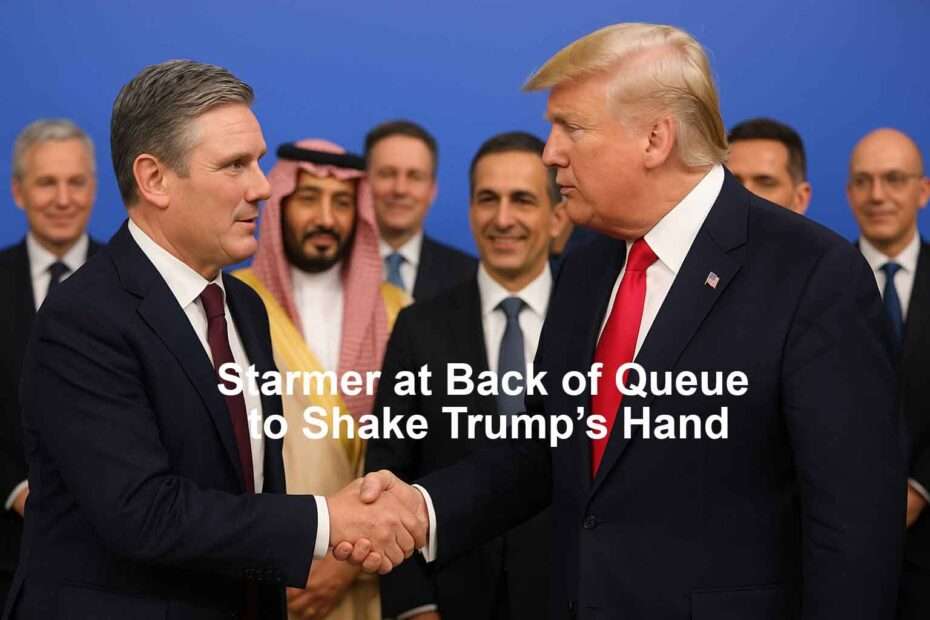Starmer at Back of Queue to Shake Trump’s Hand
A Diplomatic Gathering in Egypt
World leaders from across the globe assembled in Egypt this week for what has been hailed as a defining moment in Middle East diplomacy. The event, known as the 2025 Gaza Peace Summit, took place in Sharm El-Sheikh and drew presidents, prime ministers, and senior envoys from around 30 nations.
The summit followed the announcement of a ceasefire between Israel and Hamas — a deal widely attributed to the mediation efforts of former U.S. President Donald Trump, who returned to the international stage to present what he called a “roadmap for lasting peace.” Co-chaired by Trump and Egyptian President Abdel Fattah el-Sisi, the meeting was intended to mark a turning point in regional stability and humanitarian cooperation.
Among the many attendees was the British Prime Minister, Sir Keir Starmer, who travelled to Egypt to express the United Kingdom’s support for renewed peace efforts and to reaffirm Britain’s commitment to international diplomacy.
The Awkward Moment Caught on Camera
However, what began as a carefully choreographed diplomatic occasion soon produced an unexpected viral moment. As world leaders lined up to shake hands with President Trump following the group photo, a brief and seemingly cold exchange between Trump and Starmer drew widespread attention.
Observers noted that Starmer appeared near the back of the long queue of dignitaries waiting to greet the American leader. When his turn arrived, Trump extended his hand, gave a quick shake, and immediately turned to the next person in line without any verbal exchange or acknowledgment.
The handshake lasted only a moment — but it was enough to spark online commentary and speculation. Many saw it as a subtle yet unmistakable sign of Starmer’s peripheral position on the global stage, particularly in a room dominated by power players such as the Egyptian president, Saudi delegates, and senior U.S. officials.
Political Optics and Perceptions
In the world of diplomacy, gestures often speak louder than words, and this fleeting encounter did not go unnoticed. Some political commentators suggested that Trump’s brisk treatment of the British Prime Minister reflected a wider sense of detachment between the United States and the United Kingdom under Starmer’s leadership. Others argued that it was simply a matter of protocol and time management in a heavily structured event attended by dozens of leaders.
Nevertheless, the optics were undeniable. While Trump exchanged warm words with the Egyptian host and key regional figures, Starmer’s moment appeared fleeting and perfunctory. Social media users quickly circulated clips and screenshots, dubbing the scene “cringe-worthy” and highlighting Starmer’s apparent effort to position himself in the group photograph earlier in the day.
Starmer’s Role and Response
Starmer’s attendance at the summit was intended to project the image of a globally engaged Britain. Ahead of the event, his office released a statement affirming that the UK would “stand with all partners committed to a peaceful and stable Middle East.” During the conference, Starmer expressed support for the ceasefire initiative and emphasised the need for humanitarian aid, reconstruction, and political reconciliation.
Following the summit, Starmer downplayed the handshake moment, describing the event as “a productive gathering with a shared goal of peace.” Government sources insisted that the UK played an “important diplomatic role,” citing ongoing discussions with Egypt and Jordan over aid distribution and post-conflict recovery.
However, critics were less forgiving. Political rivals at home seized upon the image as a metaphor for Britain’s diminished influence in global affairs. One opposition MP remarked that “the UK once led from the front; now it seems we are content to wait at the back of the line.”
International Reactions
Outside Britain, reactions were mixed. Some international outlets portrayed the meeting as a triumph of diplomacy, praising Trump’s plan as a “last chance for peace in the region.” Others pointed out the lack of direct participation from Israel and Hamas, questioning how effective such a summit could be without both sides at the table.
For many observers, the focus quickly shifted from policy to personality. The contrast between Trump’s commanding presence and Starmer’s more reserved demeanour was stark. Where Trump projected confidence and authority, Starmer appeared cautious and somewhat peripheral — a difference amplified by the optics of the handshake sequence.
Symbolism and Legacy
While such diplomatic exchanges are often fleeting, they can carry symbolic weight far beyond their immediate moment. For Trump, the summit was a stage to reassert his global influence and to position himself as the architect of Middle East peace. For Starmer, it was an opportunity to demonstrate Britain’s relevance in international diplomacy — though the optics of the encounter may have undermined that message.
The incident serves as a reminder of how global politics often operates on perception as much as policy. A single handshake, or lack of one, can shape narratives, reinforce hierarchies, and leave lasting impressions about a leader’s standing in the world.
As the cameras clicked and the footage spread across news channels and social media platforms, the image of Keir Starmer standing at the back of the queue — waiting his turn to shake Donald Trump’s hand — came to symbolise something larger: the struggle of a British leader seeking a voice amid louder and more assertive global figures.

